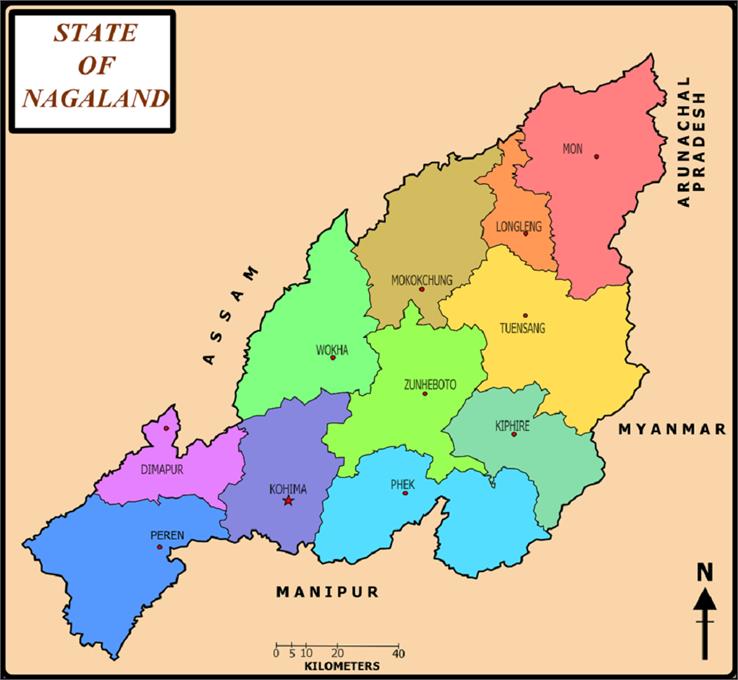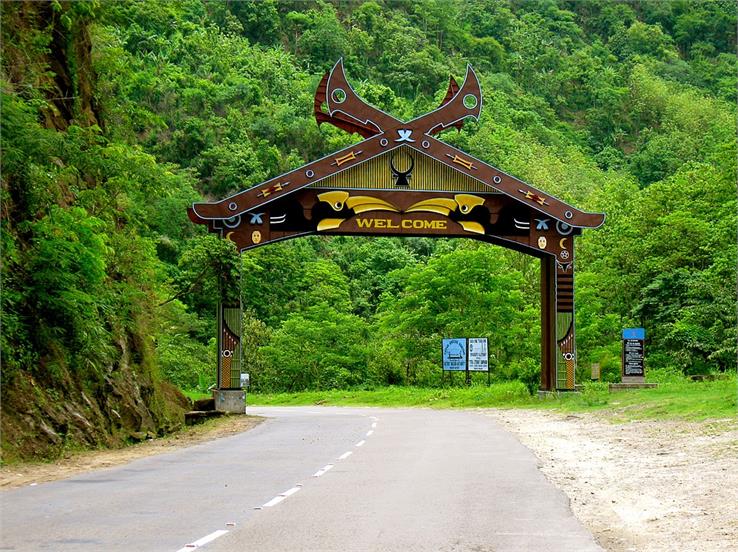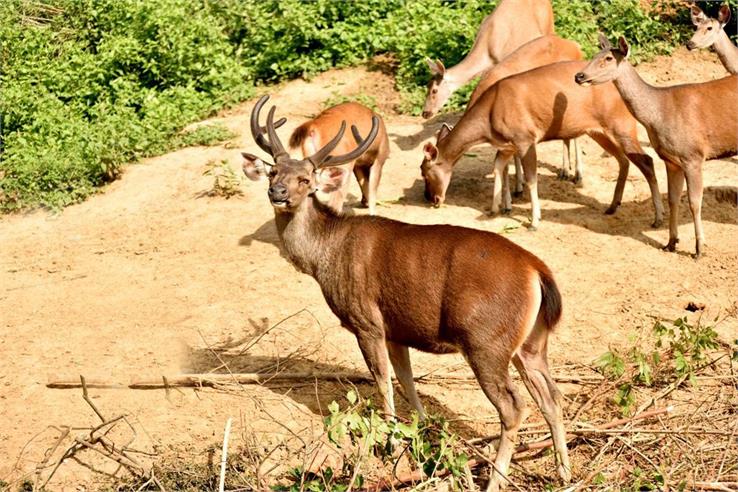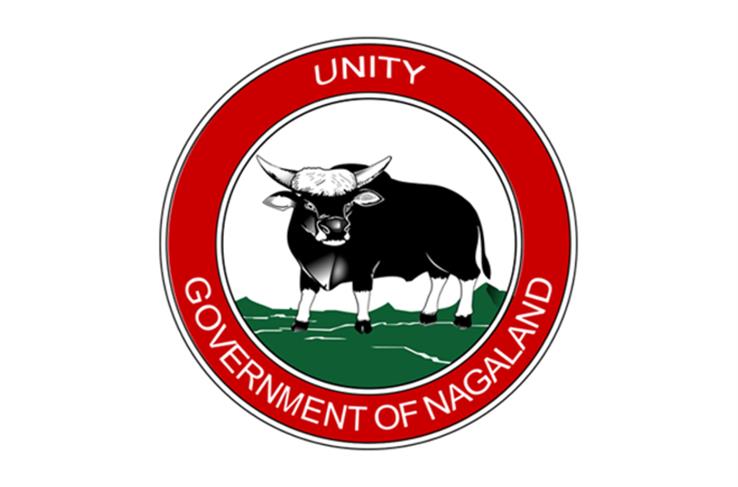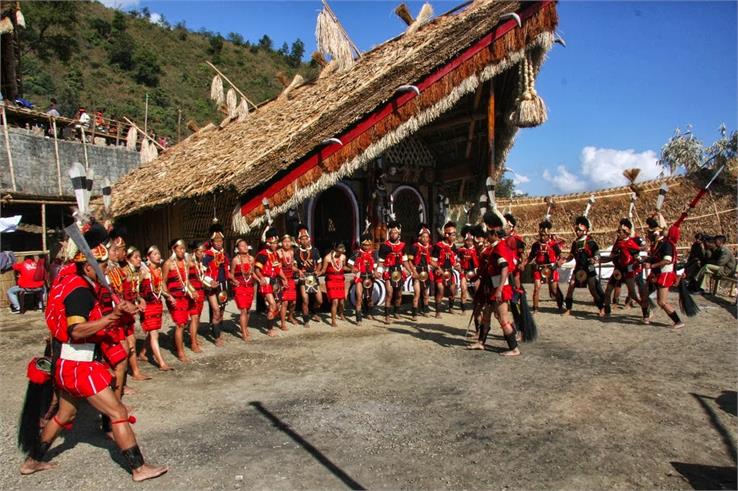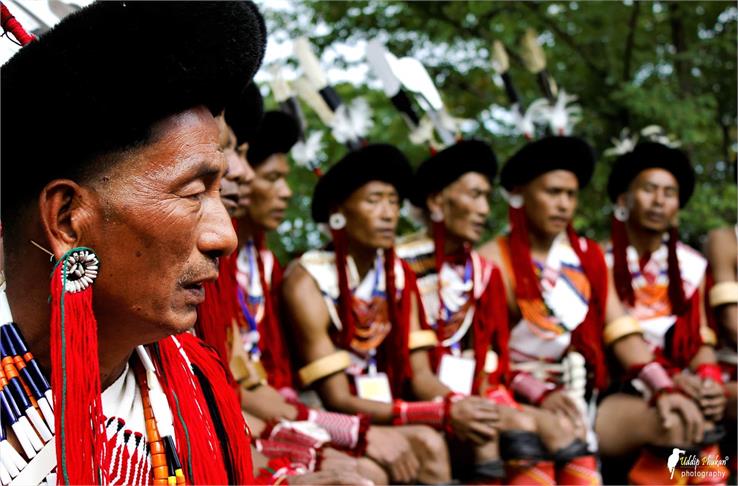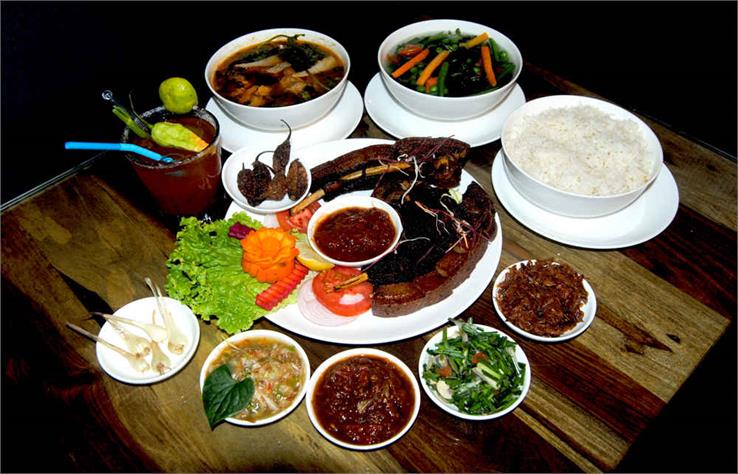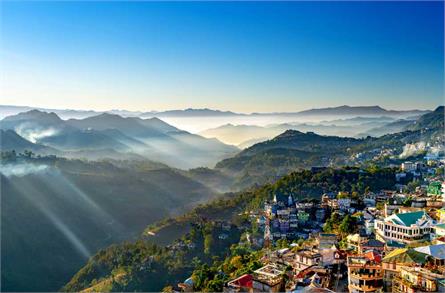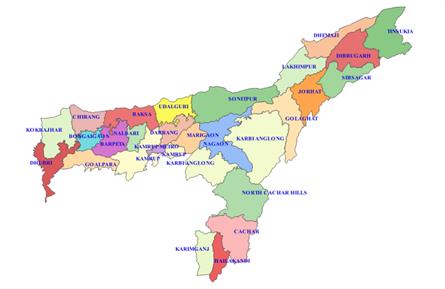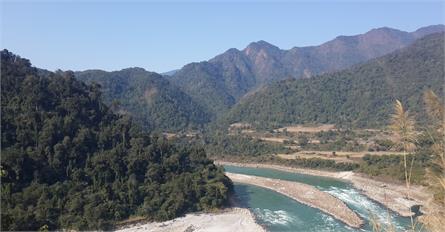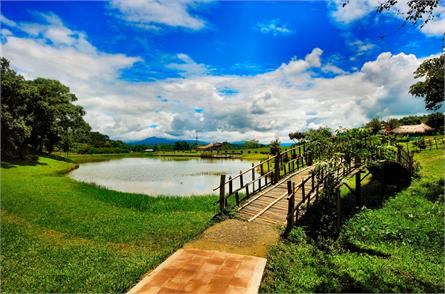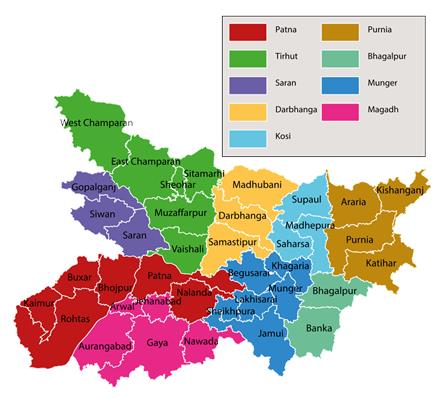Nagaland - The Switzerland of the East
The Switzerland of the East, Nagaland is a beautiful state of India which is situated on the north-east border of the country. Nagaland is also known by its nickname "Land of Festival," and is one of the most popular hill stations on the land of India. The capital of Nagaland is Kohima, and its largest city is Dimapur.
Nagaland became the 16th state of the Republic of India on 1st December 1963. Prior, Nagaland was a union territory. Nagaland is located at the extremity of the north-eastern part of India. It borders the state of Assam to the west and north, Arunachal Pradesh to the north, Myanmar to the east, and Manipur to the south. Nagaland is one of the smallest states in India.
A distinctive feature of Nagaland is that 16 different tribe groups are inhabited in the state. These groups have a distinct cultural identity that includes different rituals, clothing, and language. More than 80% percent of Nagaland's population is Christian.
History
In 1890, British rule was established in Nagaland, and the traditional practice of headhunting was outlawed. Nagaland region was the area of many Naga communities who lived in the forest in India. During the First World War, the British approached many Naga communities and sent France and Europe, where, separated from other British Indian soldiers, Nagas developed a spirit of unity. Nagas are pretty much sure that after returning to their homeland from the world war, they would unite the various Naga communities and work upon integration and friendship among them. These Nagas, together with the British authorities, formed the Naga Nationalist Movement in 1918.
Since India's independence in 1947, the Naga region remained divided between Assam and the North-East Frontier Agency. Despite strongly advocating a political union of all Naga tribes, one group continued to demand secession from India. After some violent incidents in 1957, the Indian government established a Naga administrative unit under Indian rule. The Naga people reacted by campaigning for sabotage and stopped the payment of taxes. The Government of India approved the demand of making Nagaland a self-governing state in 1963, then after it has officially declared a state.
Geography

Located in the north-eastern part of India, Nagaland shares its international border with Myanmar. The state lies between the geographical coordinates of 93°20'E and 95°15' E longitude and latitude 25°6, 'and 27°4' E. Geographically, the state is located at 25.67 degrees north and 94.12 degrees east.
Almost the whole of Nagaland is mountainous. In the north, the Naga hills rise abruptly from the Brahmaputra valley to a height of about 610 meters and then rise to 1,800 meters in the south-east direction. These hills near the Myanmar border join the Patkai mountain range. The highest peak is Mount Saramati, which has a height of 3,826 meters. The region is deeply divided by several rivers, Doyang and Dhiku in the north, Barak in the southwest, and tributaries of Chindwin River (in Myanmar) in the south-east.
Capital
Kohima is the capital city of Nagaland located in the north-eastern part of India. The name 'Kohima' was placed on a plant named 'Kyu Hee' which grows in a mountainous region. Kohima is an attractive place that embraces natural beauty. The capital city is easily accessible by any means of transport. The nearest airport is 74 km. away, located in Dimapur.
Climate
Nagaland has a largely monsoon climate with high humidity levels. The average annual rainfall ranges from 1,800 to 2,500 mm and is concentrated from May to September. The average temperature decreases with height.
Flora and Fauna

The recorded forest area of Nagaland is 8,629 sq. km, which is 52% percent of the entire geographical area. Tropical and subtropical evergreen forests are found at an altitude of less than 1,219 meters, including palm trees, cane, bamboo, and precious timber trees such as mahogany, coniferous forests. In areas where Jhum (shifting) cultivation has been harvested, tall grasses and shrubby forests have regrown. The wildlife sanctuaries are spread over an area of 222 sq. km. Rhinoceros, elephants, tigers, leopards, bears, monkeys, sambars, buffaloes, and wild bulls are found in the lower hills. Porcupine, pangolin, wild dog, fox, mongoose are also found in this state.
Economy
Nagaland is an agrarian state, where about 70 percent of the population depends upon agriculture. The agricultural sector has a significant contribution to the state. Rice is the staple crop of the state. Other major crops of Nagaland include rice, maize, jowar, bajra, pulses (like peas and legumes), and oilseeds. The state has fibrous crops, sugarcane, potatoes, and tobacco, but still, they are dependent on food imports from neighboring states. Forestry is the primary means of income and employment.
Shifting and burning of plants for shifting cultivation is very prevalent here. There are many mineral deposits here, including oil deposits, though it has been exploited a little. The state has adopted the program of industrialization since 1970. Until the early 1970s, the state only included cottage industries such as weaving, woodworking, basketry, and pottery.
Minerals
Chromium, nickel, cobalt, iron ore, and limestone are found in Nagaland, but only low-grade coal deposits are currently being mined. Mineral oil has been found in the western district of Wokha, and oil leaks in the Dikhu Valley near Assam suggest that there are mineable reserves of oil.
Industry
'Nagaland Mechanized Bricks Company Ltd.' with the capacity to produce one lakh bricks per day in Dimapur. Handloom and handicrafts are important cottage industries, which are mostly run by cooperative societies. Nagaland Handloom and Handicrafts Development Corporation Ltd., Dimapur is a government-owned corporation, which promotes handloom and handicraft products in the state. The Nagaland Industrial Development Corporation is the largest financial aid organization and guides entrepreneurs. Lack of raw materials, financial resources, electricity, poor traffic, and communication systems have hindered industrial development.
Dimapur, the leading industrial center of the state, now has a sugar mill, liquor factory, brick factory, and television factory. Other industries in the state include a Khandasari mill, rice mill, canned fruit plant, paper and pulp factory, a plywood factory, and cabinet and furniture making factory. Currently, there are only three industrial areas. There are also 23 sericulture farms located in the state.
Power and Electricity
In 1981, electricity was provided to all villages in Nagaland. So far, 100 percent of villages in Nagaland have been electrified, including remote villages. Electricity generation depends mainly on diesel plants, although hydroelectric generation has increased. More than 50 percent of Nagaland's electricity is produced in Assam.
Irrigation
There are no irrigation projects in the state. Small irrigation projects mainly divert the stream of hill springs, which are used for irrigation in paddy cultivation in the valley. The total irrigated area is 93,231.43 hectares.
Media
Like any other state media, Nagaland's media is also an important part of the state. This state of India is different, but the media ensures that all types of news, national or international, reach the people of Nagaland equally. The state's media includes television, radio, and newspapers. All Indian news, entertainment, and sports channels reach the state. In this way, it is well connected to the country. In addition to the national newspapers of India, many state newspapers are also published.
Tribes
The 'Naga' people are among the Indo-Mongoloid people who inhabited the region of the north-eastern hills of India and the upper part of western Myanmar. The main tribes of Nagaland are - Angami, Ao, Chakhesang, Chang, Khiamniungan, Kuki, Konyak, Lotha, Phom, Pochury, Rengma, Sangtam, Sema, Yimchunger and Zeliang, etc.
Administration

Nagaland has a single-chamber legislative assembly with 60 seats. The government of Nagaland is engaged in the administration and management of various departments so that the state government can function smoothly. There are several departments in the state government headed by elected ministers. These government departments are an integral part of the administration of the state. Some of these government departments are as follows:
- Accountant General Nagaland
- Health and Family Welfare
- Technical Education
- School Education
- Sericulture
- Higher Education
- Social Welfare
- Nagaland State Commission for Women
- Nagaland Police
- Nagaland Home Guard and Civil Defense
- Industries & Commerce
- Gauhati High Court Kohima Bench
- Agriculture
- Agricultural Technology Management Agency(ATMA)
- Fire and Emergency Services
- Soil and Water Conservation
- Nagaland State Information Commission
- Nagaland Pollution Control Board
Education
According to the 2011 census, the state literacy rate is 80.11 percent. The state government supervises the primary and secondary education here, and children below 14 years have the right to get free education. Most of the schools are affiliated to the Nagaland Board of Secondary Education, and some schools are affiliated to the CBSE Board. There are many colleges in Nagaland, which provide education in various faculties such as arts, science, and commerce. There are a few educational institutions that offer higher education in the fields of engineering, law, and management. The campus of North Eastern Hill University, one of the famous universities of Nagaland, is also located in Kohima.
Transport
The state of Nagaland is easily connected to other parts of India by road, rail, and air. However, connectivity to the railways is very less. It is easily accessible by road due to its proximity to many national and state highways. The Nagaland State Transport Service serves important villages and towns of the state and also has deluxe buses at night from Dimapur to Mokokchung, Guwahati, and Shillong. Apart, one can also hire a full or shared yellow taxi to roam in or around the state. Dimapur Railway Station of North East Frontier Railway is the central railway station in the state that connects Guwahati.
By Air
With the increasing popularity of Nagaland as a tourist spot, there are increasing options to reach Nagaland by air. The main airport in Nagaland is Dimapur Airport, which is five kilometers from Dimapur city center. Dimapur is the arrival and departure center for many airlines and is also connected to other tourist spots in Nagaland. Major airlines such as Indian Airlines and Air Deccan operate regular flights from Dimapur in Nagaland. Kolkata and Guwahati are two such places from where it is quite easy to reach Nagaland by air.
By Road
The road network of the state of Nagaland is excellent. Kohima, the capital of Nagaland, is well connected to Guwahati and Shillong, the two most important cities in the northeastern part of the nation. Other cities of Nagaland are also connected by road from Kohima. Road transport of Nagaland also includes state transport buses running from Dimapur to Kohima. Many luxury and private buses ply from Guwahati to the desired location. Mini coaches and taxis are also readily available from Dimapur. Although its fare is slightly higher but makes the journey comfortable.
Taxis are readily available from Dimapur to Kohima. Several night buses are connecting Dimapur and Kohima with Guwahati and Shillong. The taxi stand of Dimapur is very close to its railway station, which is quite convenient for the tourists.
By Train
Any train that goes to Dimapur railway station can be taken to reach the northeastern state of Nagaland by train. This railway station of Dimapur is the main railhead station of the state and makes traveling to Nagaland very comfortable. Traveling to Nagaland by train is very convenient for tourists. The largest railhead of the state is at Dimapur. Dimapur railway station is connected to Guwahati, which is the gateway to the northeastern part of India. The railway station of Guwahati is connected to all important parts of India by several trains. There are many trains in all major cities of the country that connect Nagaland with other parts of the country.
Cultural Life and Society

Nagaland's history and culture resemble Burma. Nagaland is the land of various tribes. It has given birth to many legendry warriors. The Nagas living in Nagaland belong to the Indo-Mongolian dynasty. The Nagas have around 16 tribes and several sub-castes due to their different geographical distribution. Although there are many cultural traits among them, they lack a lot of isolation and mutual harmony among themselves. Women have a relatively high and honorable position in Naga society. They work on the same conditions as men in the fields, and also have a significant influence in tribal councils. A central feature of Naga's life is the feast of virtue, in which Mithun (Gayal animal/ Bos frontalis) is sacrificed after several rituals. Each tribe has its own festivals, and the Naga dances, musical songs, as well as folklore reflect the euphoria of life.
Art
The art and craft of Nagaland are quite famous all over the world. The people, especially women, are proficient in the art. However, irrigation is the main occupation of the inhabitants of Nagaland. The bronze and tin metal sculptures made here are magnificent. Moreover, Nagaland is known for its beautiful jewelry, armlets, bangles, etc. These ornaments are beautifully rendered with the use of seeds. Tourists visiting Nagaland buy beautiful souvenirs of handicrafts.
Festivals
The land of Nagaland has a festive and happy atmosphere throughout the year. Various tribe groups of Nagaland celebrate some important festivals. Festivals like the Sekrenyi festival, Moatsü, Bushu Festival, Sukrunye, Yemshe, and many others are also celebrated with joy and enthusiasm. Apart from these, some major celebrations like Christmas and New Year are also observed. Due to these festivals, the state of Nagaland is known as the 'Land of Festivals.'
Hornbill Festival Nagaland

The Hornbill Festival is celebrated in Nagaland from 1st to 10th December. The Department of Arts and Culture organizes the Hornbill Festival, which reflects the culture of the state. The various types of Naga dishes, folk dances, and stories are a special part of this festival. The tourists from all over the country and abroad come to participate in this festival.
Sekrenyi Festival
A major annual festival of Angami Nagas, commonly known as Phousanyi, is observed for ten days from the 25th day of the Angami calendar month of 'Kezei.' According to the Gregorian calendar, it is celebrated around 25th February. Basically, it is held to purify the body and soul to wash all past sins. In other words, it is also known as the 'Purification Festival.'
Moatsu
Moatsu, a major festival of Ao tribes of Nagaland, celebrated every year in the first week of May after sowing is done. This is a relaxation festival, celebrated after the stressful practice of clearing fields, sowing seeds, and burning forests.
Language
Nagaland is the only state in India, which has maximum diversity in language. There are about 36 different languages and dialects that are spoken by the Naga people. Those languages fall into the Tibeto-Burmese group and are classified into three parts, such as the Western, Central, and Eastern Naga groups. English is the official of Nagaland and is the medium of Education as well.
Famous Food to Eat

During a trip to Nagaland, one can get to enjoy a unique variety of food and delicacies. Naga food cuisines are spicy due to their love for the famous king chilly. Typical Naga food includes meat dish, fish, boiled potato vegetable, crushed potato and tomato, Naga rice curry, and boiled edible organic leaves. Other mouth-watering cuisines of Nagaland consist of Bamboo shoot, Axone (fermented soybean), Fermented dry fish, Samathu, Aikibeye, Boiled Vegetables, Fish Cooked in Bamboo, Bushmeat/Dog meat, etc.
Best time to visit Nagaland
The best time to visit Nagaland is considered during the winter from October to March. Monsoon season can face terrible conditions like heavy rains and floods as Nagaland often receives heavy rainfall. One can also visit the state in summers, but winters are best to enjoy the treasure in Nagaland.
Shopping in Nagaland
The people of Nagaland have a rich tradition of arts and crafts, which makes the shopping experience very spectacular. The tradition of handicrafts blends with the natural environment, due to which they are pretty famous for their skills and creativity.
The tribal communities of the region have been dependent on dense forests for centuries. Things like wood, cane, bamboo usually work as a raw material for them. So, they used to make handicrafts that utilize their free time, and now, it has become a medium to earn money.
Whether it is an item to use or a piece of art, everything reveals the artistry and aesthetic sense of the state. With fine strips of bamboo or cane, they make beautiful baskets, bags, furniture, and from cotton, shawls, and jackets are being made. Their colors, designs, and pictures vary according to the folk tales of each tribe. These people use natural colors, beads, and shells to decorate artifacts, which are very famous around the world. The items like the basket, crockery, bags, pottery, shawls, jackets, woodwork and metalwork are worth shopping for.
Although there are no such luxurious commercial complexes where one can shop. However, there are various government emporiums and private shops to shop in. The colorful markets here offer excellent variety at reasonable prices.
Places to visit in Nagaland
Traveling to Nagaland is not only cherished by nature-lovers but also those who love tradition and the communities of Nagaland. The culture, history, and stories of Nagaland have a fantastic combination. Tourists get a glimpse of the traditional culture of the Naga community of India and relished the customs and festivals. The pleasant weather of Nagaland contributes a lot to the tourism here.
Among the major sightseeing places of Nagaland, major cities, beaches, and temples, there are many tourist places. Tourists visiting Nagaland must visit these attractions, which are mentioned below:
Dimapur
Among the major tourist destinations of Nagaland, Dimapur is the largest and fastest-growing city. These cities are directly connected through air flights, due to which the influx of tourists here is very high. Some of the major attractions of Dimapur include Triple Falls, Kachari Ruins, Nagaland Science Center and Zoological Gardens, etc. The eastern part of Dimapur city lies deep in the Dhansiri river, which presents an incredible attraction.
Khonoma
Khonoma Village is a town attracted by the 'Angami Naga' ethnic group of Nagaland. Khonoma Village is located at a distance of about 20 kilometers from Kohima, the capital city of Nagaland. Khonoma Village is known as India's first green village. It is known for protecting Nagaland tribal groups and natural habitats.
Mokokchung
Mokokchung tourist destination is one of the most famous attractions of Dimapur and Kohima. The most popular tourist destination in the region includes The Town Park. Tourists visiting Mokokchung also get an opportunity to visit attractive places such as Longkhum, Langpangkong, Mopungchuket, and Chuchuyimlang within the district. Agriculture is the main occupation of Mokokchung.
Naga Heritage Village
Among the various attractions of Nagaland, the village of Naga Heritage Village Kisama is one of them. Its objective is to preserve and promote the culture as well as traditions of the Naga people. The village is open for a week in December during the Hornbill festival celebration of the state. Tourists come from far and wide to visit these beautiful villages of Nagaland.
Phek
Phek tourist destination is a mountainous area included in Nagaland, which is rich in flora and fauna. Apart from this, spellbinding hills and Shillai lake are the important attractions of Nagaland. The beautiful hills in the Phek district, such as Kapamodzu, and Zanibou enhance its beauty.
Dzukou Valley
Situated amidst the beautiful scenery of Nagaland, the Dzukou (Dzüko) Valley is an attractive tourist destination located about 25 km from Kohima. Nagaland is known as the Switzerland of the East, and the Dzukou Valley and Saramati Peak have a lot of beauty and charm. This attracting valley fills the journey of tourists who are fond of trekking. The height of the Saramati Peak (Japfu peak) is 3048 meters, which is the second-highest peak in Nagaland.
Tuensang
One of the most beautiful attractions of Nagaland is Tuensang. It is known as the largest district of eastern Nagaland and adjoining Myanmar on the right. Tuensang is one of the largest urban centers in Nagaland, along with Dimapur, Kohima, and Mokokchung.
Kohima
Kohima is the hill capital of Nagaland, one of the major tourist destinations of Nagaland. Kohima is one of the most peaceful and mesmeric sites in seven sisters of northeast India. The capital of Nagaland was given the name Kohima by the British. Earlier, its name was 'Kewhira.' The name Kewhira originated due to the beautiful flowers found in this region. This place is located at an altitude of about 1500 meters above sea level. Kohima is also considered an ideal place for trekking enthusiasts.
Mon Village
Mon tourist destination is a rare area along the steep slopes of the foothills district. Mon tourist places may not be in the vicinity of attracting tourist places, but it has its own importance in terms of tourism.
Shilloi Lake
Shilloi Lake is a beautiful lake situated in the middle of the Patkai hills in Nagaland. The Vardhman Valley is located around Shilloi Lake. This lake is considered very important by the residents of Latsam village. It is said that a child's holy soul resides in this lake.
A trip to Nagaland is an excellent option for tourists seeking peace and relaxation. Nagaland is situated amidst the foothills of the eastern Himalayas and is one of the beautiful states located in the northeastern part of India. So, celebrate your visit to Nagaland and enjoy exclusive tourist destinations with extreme serenity.


